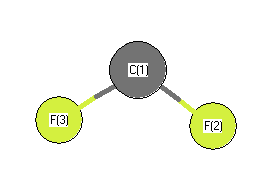Jump to
S2C1
Energy calculated at QCISD/6-31G
| | hartrees |
|---|
| Energy at 0K | -236.909516 |
| Energy at 298.15K | -236.909200 |
| HF Energy | -236.569117 |
| Nuclear repulsion energy | 61.092256 |
The energy at 298.15K was derived from the energy at 0K
and an integrated heat capacity that used the calculated vibrational frequencies.
Geometric Data calculated at QCISD/6-31G
Point Group is C2v
Cartesians (Å)
| Atom |
x (Å) |
y (Å) |
z (Å) |
|---|
| C1 |
0.000 |
0.000 |
0.644 |
| F2 |
0.000 |
1.084 |
-0.215 |
| F3 |
0.000 |
-1.084 |
-0.215 |
Atom - Atom Distances (Å)
| |
C1 |
F2 |
F3 |
| C1 | | 1.3828 | 1.3828 |
F2 | 1.3828 | | 2.1688 | F3 | 1.3828 | 2.1688 | |
 More geometry information
More geometry information
Calculated Bond Angles
| atom1 |
atom2 |
atom3 |
angle |
|
atom1 |
atom2 |
atom3 |
angle |
| F2 |
C1 |
F3 |
103.289 |
|
Electronic energy levels
Electronic state
Charges, Dipole, Quadrupole and Polarizability
Jump to
S1C1
Energy calculated at QCISD/6-31G
| | hartrees |
|---|
| Energy at 0K | -236.843725 |
| Energy at 298.15K | -236.843342 |
| Nuclear repulsion energy | 59.169416 |
The energy at 298.15K was derived from the energy at 0K
and an integrated heat capacity that used the calculated vibrational frequencies.
Geometric Data calculated at QCISD/6-31G
Point Group is C2v
Cartesians (Å)
| Atom |
x (Å) |
y (Å) |
z (Å) |
|---|
| C1 |
0.000 |
0.000 |
0.518 |
| F2 |
0.000 |
1.199 |
-0.173 |
| F3 |
0.000 |
-1.199 |
-0.173 |
Atom - Atom Distances (Å)
| |
C1 |
F2 |
F3 |
| C1 | | 1.3838 | 1.3838 |
F2 | 1.3838 | | 2.3988 | F3 | 1.3838 | 2.3988 | |
 More geometry information
More geometry information
Calculated Bond Angles
| atom1 |
atom2 |
atom3 |
angle |
|
atom1 |
atom2 |
atom3 |
angle |
| F2 |
C1 |
F3 |
120.170 |
|
Electronic energy levels
Electronic state
Charges, Dipole, Quadrupole and Polarizability
